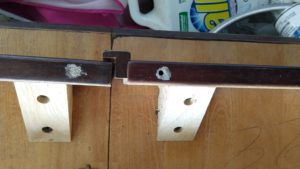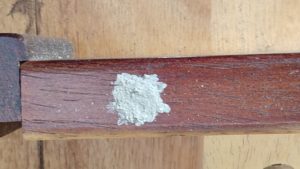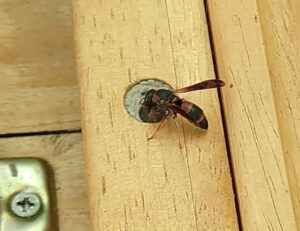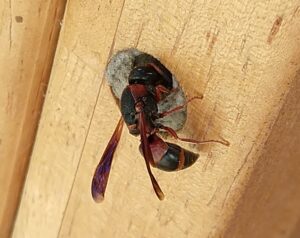Someone was kind enough to give me a table. They helped to load it into my small car but when arrived home and tried to move the table from my car to the house, it was too heavy for me to move on my own. After a good deal of grunting and cursing, I finally managed to get the table onto the front porch where at least it won’t get rained on. Here it is, weeks later and the table and the legs are still on the porch. If anyone stops by to visit I will beg them to help me move the table inside the house and maybe they will help to attach the legs.
But wait…no…I cannot bring the table into the house just yet.
Why not?
There are holes in the underside of the table – but wait, I forgot to say that the tabletop is laying on its side so the screw holes are horizontal. This attracted a very small, mostly black bee and she’s been laying eggs in the screw holes of the table.
The tiny bee has gradually been filling each hole with eggs and sealing the hole with mud.
Where is she getting the mud?
I have a lovely hole in my driveway which I filled with clay and small stones. Some day I will repair the hole properly. Every time it rains, the hole is a mud wallow mixed with good old Georgia clay and that’s exactly what the bee needs to seal the holes. The small stones assure that she will not drown while collecting mud.
Seems like procrastination works in the bee’s favor.
She was kind enough to land for a moment so I could get a glimpse. She is mostly shiny and black, her abdomen is somewhat striped with white. After her short rest, she went back to work so that’s all I have to go on for an identification.
I found a link to help identify bees. Looking at the images in the link, I think she may be a sweat bee. If she stays still again and I have a camera I’ll try to get a photo.
htts://www.mnn.com/your-home/organic-farming-gardening/stories/how-identify-different-types-bees
Here are the screw holes in the table. The hole on the bottom right is the one she’s working on. The hole above that one is sealed.

This is one of the holes sealed with clay and mud. 
After doing some research I learned that the bee lays female eggs first and lays the male eggs last. The males hatch out first and hang around waiting for the females to emerge. I have more research to do. I need to know how many weeks or months the table has to stay on the porch so the bees can hatch out.
Since there is a constant source of mud/clay/water and plenty of flowers blooming late in the season, all that needs to be done is to make some bee hotels so the bees can have a more appropriate place to lay eggs next time.
UPDATE: Feb 5, 2020
It has taken a long while for me to revisit this post. It’s not a bee nursery. It’s both a bee and a wasp nursery. In addition to the original yet unidentified bee there is a Red and Black Mason Wasp using the table as a nursery. This wasp is also known as Pachodynerus erynnis. 

Here are some links if you want to learn more.
https://en.wikipedia.org/wiki/Pachodynerus_erynnis
https://aggie-horticulture.tamu.edu/galveston/beneficials/beneficial-39_red_and_black_mason_wasp.htm
https://bugguide.net/node/view/6244
I was happy to grab a few photos. Here is a video that someone captured of the wasp on a flower. Don’t blink; the video is only 3 seconds long.
https://www.youtube.com/watch?v=xdxbx3jEweo
Well, it has really been a long time. All the little bees and wasps have hatched and flown away so I was finally able to give the table to my neighbor. In the spring, I’ll make an effort to create a new bee and wasp nursery. Wish me luck.